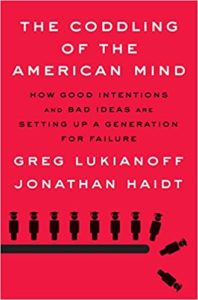 (Excerpts and thoughts on The Coddling of the American Mind by Greg Lukianoff & Jonathan Haidt)
(Excerpts and thoughts on The Coddling of the American Mind by Greg Lukianoff & Jonathan Haidt)
In 2014, Lukianiff & Haidt set out to understand what was happening on college campuses.
However, they ended up telling a story of our strange and unsettling times; when many institutions are malfunctioning, trust is declining, and a new generation- the one after the Millennials- is graduating and entering the workforce.
Although Lukianoff & Haidt focus on the concerns they are seeing on college campuses, I believe their insights extrapolate to us all.
- The Untruth of Fragility: What doesn’t kill you makes you weaker.
- The Untruth of Emotional Reasoning: Always trust your feelings.
- The Untruth of Us Versus Them: Life is a battle between good people and evil people.

Note: To be classified as a Great Untruth, an idea must meet the following three criteria:
- It contradicts ancient wisdom (ideas found widely in the wisdom literature of many cultures).
- It contradicts modern psychological research on well-being.
- It harms the individuals and communities who embrace it.
The Untruth of Fragility
Antifragile is a book written by a Nassim Nicholas Taleb, a Lebanese born statistician, stock trader, and polymath who is now a professor of risk engineering at New York University. Taleb has done a marvelous job of explaining the harm of avoiding stressors, risks and small doses of pain. Taleb argues that most of us think about risk in the wrong way. An oversimplified understanding of his explanation is that that we err on assessing risk by looking at our past experiences. Yet, in complex systems, it is virtually inevitable that unforeseen problems will occur. (Although I am not much of a mathematician, I do know that Taleb was one of the few who predicted the financial crisis of 2008, due to his understanding of typical errors in risk assessment.)
Taleb encourages us to differentiate three types of things. “Some like china cups, are fragile: they break easily and cannot heal themselves, so you must handle them gently and keep them away from toddlers. Other things are resilient: they can withstand shocks. Parents usually give their toddlers plastic cups precisely because plastic can survive repeated falls to the floor, although the cups do not benefit from such falls.” But Taleb asks us to look beyond the overused word ‘resilience’ and recognize that some things are antifragile. Many of the important systems in our economic and political life are like our immune systems: they require stressors and challenges in order to learn, adapt, and grow. Systems that are antifragile become rigid, weak, and inefficient when nothing challenges them or pushes them to respond vigorously…muscles, bones and children are antifragile.” (Lukianoff & Haidt, 2019)
The Untruth of Emotional Reasoning
“What really frightens and dismays us is not external events themselves, but the way in which we think about them. It is not things themselves, but the way we think about them. It is not things that disturb us, but our interpretation of their significance.”
–EPICTETUS, 1st-2nd century
“Our life is the creation of our mind.” –Buddha
“There is nothing either good or bad, but thinking makes it so.” –Shakespeare
“The mind is its own place, and in itself can make a heaven of hell, a hell of heaven.” -Milton
Cognitive Behavioral Therapy (CBT) was developed by Aaron Beck, a psychiatrist at the University of Pennsylvania, in the 1960s. Beck’s great discovery was that it is possible to break the disempowering feedback cycle between negative beliefs and negative emotions. CBT is a method anyone can learn for identifying common cognitive distortions and then changing their habitual patterns of thinking. Emotional reasoning is among the most common of all cognitive distortions; most people would be happier and more effective if they did less of it. (At the end of this blog, I will list additional cognitive distortions, I like to call them “traps”) and a CBT intervention if you would like to try it out.
The Untruth of Us Versus Them
Independent of the origin story to which you subscribe, it’s apparent that the human mind evolved for living in tribes that engaged in frequent (and often violent) conflict. Thus, our modern mind quickly divides the world into “us” and “them” even on trivial and arbitrary criteria. (See Henri Tajfel’s psychological experiments for examples.)
The Reverend Dr. Martin Luther King Jr. embodied what Lukianoff & Haidt (2019) call common-humanity identity politics. Dr. King appealed to the shared morals and identities of Americans by using the unifying languages of religion and patriotism. He continually used the metaphor of family in referring to all people as “brothers” and “sisters.”
Common-humanity politics can still be found in many forms and in many places. However, in recent years, we’ve seen a rapid rise of a different form that is based on uniting and mobilizing multiple groups to fight against a common enemy. (Lukianoff & Haidt speak to this, specifically, on college campuses.) Common-enemy politics can be understood through an old Bedouin proverb: “I against my brothers. I and my brothers against my cousins. I and my brothers and my cousins against the world.” Identifying a common enemy is an effective way to enlarge and motivate your tribe.
Common enemy identity politics (in conjunction with microaggression theory; which I’m not going into for length’s sake), produces a call-out culture in which almost anything one says or does could result in public shaming. Call-out cultures are detrimental to education and to mental health. Call-out cultures and us-versus them thinking do not align with our educational and research missions; which require free inquiry, dissent, evidence-based argument and intellectual honesty.
Unfortunately, as a result of these Great Untruths, we are seeing college students fear exposure to ideas other than to their own. Due to a number of misperceptions, students are now communicating that they fear they will be harmed by being exposed to ideas to which they do not already subscribe. Of course, this closed-system of thinking not only deconstructs the concept of education, but it also brings rise to a heightened culture of fear merely at the idea of being exposed to alternative thoughts or ideas. Of course, this is a catastrophe. If this is our way, our children will never be allowed to grow into empathetic & understanding adults, with critical thinking skills. In a best-case-scenario, we raise closed-minded individuals. In a worst case scenario, we create an Us Versus Them society that feels justified in censorship of any ideas to which one does not subscribe, and feels entitled to violent measures as a way to ensure adherence to it’s belief system. Of course, in a society where all members do not agree, this will cause in-fighting among any groups who do not agree with each other. As for me, I would rather try to understand where people are coming from; even if I do not agree. Understanding is not harmful.
*If you would like to see more discussion on this, consider reading THE CODDLING OF THE AMERICAN MIND: HOW GOOD INTENTIONS AND BAD IDEAS ARE SETTING UP A GENERATION FOR FAILURE by Greg Lukianoff & Jonathan Haidt
If you would like to give CBT a try…
Categories of Distorted Automatic Thoughts
- MIND READING: You assume that you know what people think without having sufficient evidence of their thoughts. “He thinks I’m a loser.”
- FORTUNE TELLING: You predict the future negatively: Things will get worse, or therei is danger ahead. “I’ll fail that exam,” or “I won’t get the job.”
- CATASTROPHIZING: You believe that what has happened or will happen will be the worst case scenerios, and that it will be so bad you won’t be able to handle it. “ It will be so terrible if I fail, and I will probably get kicked out of school.”
- LABELING: You assign global negative traits to yourself and others. “I’m undesirable,” or “He’s a rotten person.”
- DISCOUNTING POSITIVES: You claim that the positive things you or others do are trivial. “That’s what wives are supposed to do-so it doesn’t count when she’s nice to me” or “Those successes were easy so they don’t matter.”
- NEGATIVE FILTERING: You focus almost exclusively on the negatives and seldom notice the positives. “Look at all the people who don’t like me.”
- OVERGENERALIZING: You perceive a global pattern of negatives on the basis of a single incident. “This generally happens to me. I seem to fail at a lot of things.”
- DICHOTOMOUS THINKING: You view events or people in all-or-nothing terms. “I get rejected by everyone,” or “It was a complete waste of time.”
- SHOULDS: You interpret events in terms of how things should be, rather than simply focusing on what is. “I should do well. If I don’t them I’m a failure.”
- PERSONALIZING: You attribute a disproportionate amount of then blame to yourself for negative events, and you fail to see that certain events are also caused by others. “The marriage ended because I failed.”
- BLAMING: You focus on the other person as the source of your negative feelings, and you refuse to take responsibility for changing yourself. “ She’s to blame for the way I feel now” or “My parents caused all my problems.”
- UNFAIR COMPARISONS: You interpret events in terns of standards what are unrealistic- for example, you focus primarily on others who do better than you and find yourself interior in the comparison. “She’s more successful than I am” or “Others did better than I did on the test.”
- REGRET ORIENTATION: You focus on the orientation that you could have done better in the past, rather than on what you can do better now. “ I could have had a better job if I tried,” or “ I shouldn’t have said that.”
- WHAT IF: You keep asking yourself a series of questions about “what if” something happens, and you fail to be satisfied with any of the answers. “What if I get anxious?” or “What if I embarrass myself in front of all those people?”
- EMOTIONAL REASONING: You let your feelings guide your interpretation of reality. “ I feel depressed; therefore, my marriage is not working out.”
- INABILITY TO DISCONFIRM: You reject any evidence or arguments that might contradict your negative thoughts. For example, when you have the thought “I’m unlovable,” you reject as irrelevant any evidence that people like you.
- JUDGEMENT FOCUS: You view yourself, others, and events in terms of evaluations as good-bad or superior-inferior, rather than simply describing, accepting and understanding. You are focused on the judgments of others and your own judgments of yourself. “I didn’t perform well in school” or “Look how successful he is. I’m not successful.”
How to do CBT:
CBT is relatively easy to learn, but it is like physical therapy; if you don’t do the exercises, it won’t get better. The basic process goes something like this:
- When you are feeling anxious, depressed or distressed, take a moment and write down how you are feeling.
- Rate your level of distress (I like to use a rating of 1-10; it’s not on there if it’s a zero.)
- Write the any events that precipitated your distressing feelings. (ie. My romantic interest canceled our date.)
- Write down the automatic thoughts that are now going through your head. (ie. “This always happens.” I’m a total loser.” I’ll never meet someone who wants to be with me.”)
- Look at the categories of distorted thoughts and identify any possible “traps” for each of your automatic thoughts.
- Look at the evidence for and against your thought(s). Ask yourself what someone might say who disagreed with you. Consider what you might say to a friend in the same situation.
- Now, consider what happened, and reevaluate without your cognitive distortions.
- Write down your new thoughts and feelings.
- Write down again, using the same scale as before, how anxious, depressed or distressed you feeling. Perhaps the number has done down.
*Practice, practice, practice.



